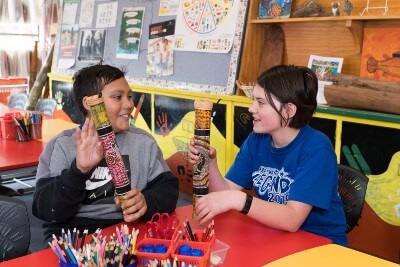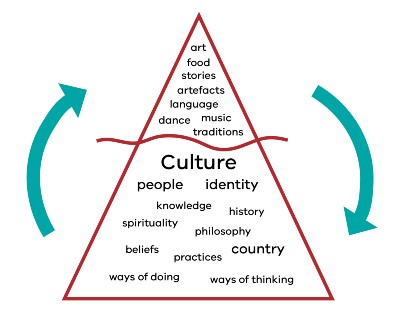Drawing on personal and professional experience, Professor Chris Matthews argues that a richer mathematics education comes from teaching from a cultural perspective.
Download this monograph
Teaching mathematics from a cultural perspective
Introduction

Before you read this article, I would like to give the reader an understanding of who I am and my personal and professional journey into mathematics education. First, I’m from the Quandamooka people of Minjerribah (Stradbroke Island) and our Country spans the Islands and mainland of Moreton Bay near Brisbane in Queensland. I was born and raised away from my Community in Toowoomba, and there, my educational experience was marred with racism from both teachers and students.
To deal with these situations, I was lucky that I had a keen interest in computing and mathematics and would disappear into this world. This world gave intellectual challenges and an appreciation for how mathematics could recreate patterns that existed in our world, that existed on Country.
Eventually this would lead me to complete a PhD in applied mathematics, but this was not a healthy educational pathway. I disconnected myself from the world, from people, from my sense of self and from my culture.
Over the years to come, I had to deal with this disconnection and making a space for myself, as an Aboriginal person, in both my professional and personal life.
As a research mathematician, I was continually confronted with circumstances where I was pushed aside and not treated as a valued colleague. I was also confronted with applications of mathematics (e.g. dumping of nuclear waste) that did not match my personal values and knew that these applications adversely affected Indigenous communities around the world. I started to understand that mathematics could be used as a tool of the coloniser and, for this reason, knew it was important for our people to understand this knowledge and how it affects our lives.
I also knew that we are an intellectual people who understand systems and patterns (e.g. how the world is interconnected), which are important aspects of our deep connection to Country. Our people understood the world mathematically in our own way and this knowledge has not been recognised. Our children are continually disadvantaged in the education system and current educational statistics do not reflect their intelligence and ability.
So how do we work together to change this? After many years as an applied mathematician, I decided to change fields to work in mathematics education for Aboriginal and Torres Strait Islander learners. I was keen to explore what it meant to teach mathematics that valued our cultures. I wanted to explore the connections between our cultures and mathematics to further inform mathematics education for all Aboriginal and Torres Strait Islander learners.
In this monograph, I will argue that a richer mathematics education comes from teaching mathematics from a cultural perspective. From this way of teaching, a different type of mathematics education can be created; the potential for students to develop a deeper conceptual understanding of mathematics as well as develop a connection with mathematics.
To do this, we must understand the connection between mathematics and culture. Drawing on my experience from delivering professional learning workshops for in-service and pre-service teachers, the following section briefly explores two fundamental questions:
- What is Culture?
- What is Mathematics?
What is culture
Iceberg model
 Figure 1 is a typical example from a professional learning workshop exploring the question “What is Culture?” using the metaphor of an iceberg, represented by the triangle, and the water line represented by the wavy line.
Figure 1 is a typical example from a professional learning workshop exploring the question “What is Culture?” using the metaphor of an iceberg, represented by the triangle, and the water line represented by the wavy line.Figure
1: Long description
A triangle shape is displayed representing an iceberg.
Words above the line are art, food, stories, artefacts, language, dance, music, traditions.
Below the line are the words culture, people, identity, knowledge, history, spirituality, philosophy, beliefs, country, practices, ways of doing, ways of thinking.
Two arrows indicate a dynamic relationship between the words above and below the line.
The iceberg metaphor has two main parts: the visible part situated above the water line and the invisible part situated below the water line. The visible part represents the tangible aspects of culture that we can experience through our senses like art, music and language. The invisible part represents the intangible aspects of culture like history, values and philosophy.
There is a dynamic relationship between these two aspects of culture represented by the blue arrows as in Figure 1. In this dynamic, the intangible aspects of culture inform the tangible aspects of culture. In other words, our history, beliefs, philosophy and so on inform how we express ourselves and interact with the world around us.
This dynamic is represented by the blue arrow on the right. As we interact with the world through our tangible culture, we also have an opportunity to learn from a multitude of experiences and learn from other people’s cultural expressions. These experiences provide us with an opportunity to reflect and evaluate our beliefs, our history and other aspects of our intangible culture and the cycle continues.
This dynamic happens on all different scales from the individual scale to the national scale. A good example of this is the debate around celebrating Australian Day on the 26th January.
This debate is an opportunity to listen to a broad range of opinions and to decide for yourself, at the individual scale, whether you personally choose to celebrate on the 26 January or not. Also, some local councils have decided to shift the day while others have not. While at the national scale the leadership has decided to uphold tradition and continue to celebrate Australia Day on 26 January.
It is also important to note that Aboriginal and Torres Strait Islander peoples have been undertaking this process for 80,000+ years and over that time have developed complex societal structures, complex knowledge systems and a plethora of languages across Australia. In essence, culture encompasses all aspects of our lives. It informs our identity, our beliefs, the way we view the world, and how we behave and interact with the world.
Activity 1:
Take the time to reflect and write down what culture means to you and compare this to the written text in Figure 1.
What is mathematics
Mathematics is often portrayed as an abstract knowledge that is free from bias i.e. free from influence of people and culture. In other words, mathematics is objective, and through this objectivity, mathematics is often linked to “finding the truth”.
Within this viewpoint, the beauty of mathematics comes from its precision, its unwavering logic and its power to solve “real world” problems. This view has also resulted in a mathematics education that is focused on students’ learning mathematical processes and procedures to solve a set of problems from textbooks and worksheets with a proportion of these problems claiming to have “real world” application.
This type of education has several important implications. First, it teaches students to be slave to mathematical processes where students search for the right procedure to apply to a particular problem. In other words, the mathematics is telling the student how to act. It also leads to the notion that mathematics is always either right or wrong, which will inevitably result in a student experience where they feel either successful at mathematics or that they are failing at mathematics.
This dynamic also acts as a filter that only allows certain individuals, who are perceived to have special innate abilities in mathematics, to progress in mathematics education. In essence, mathematics education has created a process of disconnection which is often reflected in statements from students like “What are we learning this for?” and “I will never use this again”.
Teaching mathematics from a cultural perspective allows students to connect with the meaning and purpose of mathematics
Activity 2:
Reflect on the above two paragraphs, write down what mathematics means to you and your experience with mathematics. Explore the connections between your mathematics story and the concepts in the Iceberg Model from Activity 1.